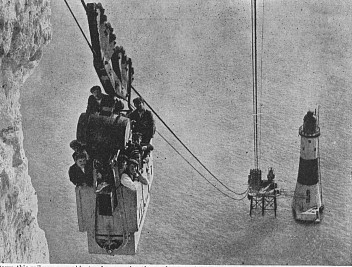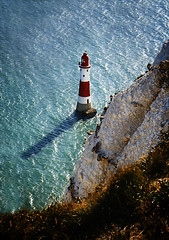Actually, maybe it was bluer.
Beachy Head is the name of the tallest chalk cliff on the south coast.
On a sunny day it's a very pretty spot.
More morosely, it's also a popular suicide spot, which is sad.
I guess if things are bad enough that you're going to jump off a cliff, this at least is a very pretty one...
Beachy Head is a chalk headland on the south coast of England, close to the town of Eastbourne in the county of East Sussex, immediately east of the Seven Sisters. The cliff there is the highest chalk sea cliff in Britain, rising to 162 m (530 ft) above sea level. The peak allows views of the south east coast from Dungeness to the east, to Selsey Bill in the west. Its height has also made it a notorious suicide spot.

The name Beachy Head appears as 'Beauchef' in 1274, and was 'Beaucheif' in 1317, becoming consistently Beachy Head by 1724, and has nothing to do with beach. Instead it is a corruption of the original French words meaning "beautiful headland".
In 1929 Eastbourne bought 4,000 acres (16 km2) of land surrounding Beachy Head to save it from development at a cost of about £100,000.
The prominence of Beachy Head has made it a landmark for sailors in the English Channel. It is noted as such in the sea shanty Spanish Ladies :
"The first land we sighted was called the Dodman,
Next Rame Head off Plymouth, off Portsmouth the Wight;
We sailed by Beachy, by Fairlight and Dover,
And then we bore up for the South Foreland light."
The ashes of German social scientist and philosopher Friedrich Engels, one of the fathers of communism were scattered off Beachy Head cliffs into the Channel, as he had requested.
Position 50° 44' 0 N 00° 14'.50 E

































































































.jpg)






























































































































